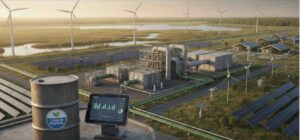The transition to renewable energy is a cornerstone of global efforts to achieve net-zero emissions and mitigate the impacts of climate change. Net-zero emissions refer to balancing the amount of greenhouse gases emitted with the amount removed from the atmosphere, ultimately leading to no net increase in atmospheric greenhouse gases. Renewable energy sources, such as solar, wind, hydro, and geothermal, play a crucial role in this transition by providing clean alternatives to fossil fuels, reducing greenhouse gas emissions, and supporting a more sustainable energy system.
**1. Key Renewable Energy Sources and Their Impact
- Solar Energy: Solar power harnesses energy from the sun using photovoltaic (PV) panels or concentrated solar power (CSP) systems. Solar energy has seen rapid growth due to falling costs, technological advancements, and its potential to provide clean electricity at scale. It reduces reliance on fossil fuels, mitigates air pollution, and decreases greenhouse gas emissions.
- Wind Energy: Wind turbines convert the kinetic energy of wind into electricity. Wind power is one of the most cost-effective forms of renewable energy and can be deployed both onshore and offshore. Wind energy contributes significantly to reducing carbon emissions and has the potential to generate large amounts of clean electricity.
- Hydropower: Hydropower generates electricity by using the energy of flowing water, typically from rivers or dams. While large-scale hydropower can provide significant amounts of clean energy, it also has environmental impacts, such as ecosystem disruption and displacement of communities. Small-scale and run-of-river hydropower projects can mitigate some of these concerns.
- Geothermal Energy: Geothermal power utilizes heat from the Earth’s interior to generate electricity or provide direct heating. Geothermal energy is a stable and reliable source of clean energy with a small land footprint and low greenhouse gas emissions.
- Biomass and Bioenergy: Biomass energy comes from organic materials such as wood, agricultural residues, and waste. When managed sustainably, biomass can provide a renewable source of energy and contribute to reducing net greenhouse gas emissions by offsetting the need for fossil fuels.
**2. How Renewable Energy Supports Net-Zero Goals
- Decarbonizing the Power Sector: The power sector is a major source of greenhouse gas emissions. Transitioning to renewable energy sources can significantly reduce emissions from electricity generation, which is crucial for meeting net-zero targets. Many countries and regions have set ambitious goals to phase out coal and other fossil fuels in favor of renewables.
- Electrification of Other Sectors: Renewable energy enables the electrification of sectors traditionally reliant on fossil fuels, such as transportation and heating. For instance, electric vehicles (EVs) powered by renewable electricity can reduce emissions in the transportation sector, while renewable-powered heat pumps can lower emissions in residential and commercial heating.
- Energy Storage and Grid Flexibility: Renewable energy sources like solar and wind are intermittent, meaning they don’t produce electricity consistently. Advances in energy storage technologies, such as batteries, and improvements in grid management can help integrate renewable energy into the grid, ensuring a stable and reliable supply of clean energy.
- Economic Benefits and Job Creation: The renewable energy sector is a significant driver of economic growth and job creation. Investments in renewable energy infrastructure and technology can stimulate local economies, create new job opportunities, and support the transition to a low-carbon economy.
**3. Challenges and Considerations
- Intermittency and Reliability: The variable nature of renewable energy sources can pose challenges for grid stability and reliability. To address this, it is essential to invest in energy storage solutions, grid modernization, and diversified energy sources to ensure a continuous supply of electricity.
- Resource and Environmental Impacts: While renewable energy has a lower environmental impact compared to fossil fuels, some technologies have associated challenges. For example, large-scale hydropower projects can affect aquatic ecosystems, and the production of solar panels and wind turbines involves the use of raw materials and energy.
- Infrastructure and Investment Needs: Transitioning to a renewable energy system requires significant investments in infrastructure, including renewable energy generation, storage systems, and grid upgrades. Public and private sector collaboration is crucial to funding and implementing these investments.
**4. Case Studies and Success Stories
- Denmark: Denmark is a global leader in wind energy, with wind turbines providing a substantial portion of the country’s electricity. The country aims to achieve net-zero emissions by 2050, with wind power playing a central role in its strategy.
- Germany: Germany’s Energiewende (energy transition) policy has driven substantial growth in renewable energy, particularly solar and wind power. The country has made significant progress in reducing emissions and increasing its renewable energy share.
- Costa Rica: Costa Rica has achieved remarkable success in using renewable energy for electricity generation, with over 99% of its electricity coming from renewable sources, including hydro, wind, and solar power.
**5. The Path Forward
To achieve net-zero emissions, it is essential to accelerate the deployment of renewable energy technologies, improve energy efficiency, and support innovations in clean energy solutions. Governments, businesses, and individuals must work together to overcome challenges, invest in sustainable energy infrastructure, and promote policies that encourage the transition to a low-carbon economy.
Conclusion
Renewable energy is a vital component of the strategy to achieve net-zero emissions and combat climate change. By replacing fossil fuels with clean energy sources, improving energy efficiency, and investing in advanced technologies, we can reduce greenhouse gas emissions, enhance energy security, and build a more sustainable future. As the world continues to confront the challenges of climate change, the role of renewable energy in shaping a resilient and low-carbon energy system will be increasingly critical.
Read more on Sparkview Energy:
Sustainable Practices in the Upstream Oil and Gas Sector
Investing in Renewable Energy: Diversification Strategies for Oil Companies
Harnessing the Potential of Renewable Energy in 2024 and beyond







